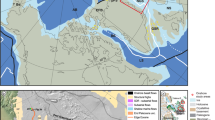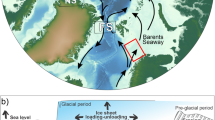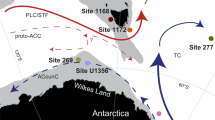Abstract
WIDESPREAD ocean floor unconformities around Australia have been explained by nondeposition of sediment and erosion by deep-sea currents, which undoubtedly occurred. The irregular duration of their hiatuses is in contrast to the widespread, brief but regularly terminated, early Oligocene unconformity on the continent. It is suggested here that the Palaeogene unconformities in Australia and the surrounding ocean basins have been derived from two different and possibly unrelated causes.
This is a preview of subscription content, access via your institution
Access options
Subscribe to this journal
Receive 51 print issues and online access
$199.00 per year
only $3.90 per issue
Buy this article
- Purchase on Springer Link
- Instant access to full article PDF
Prices may be subject to local taxes which are calculated during checkout
Similar content being viewed by others
References
Kennett, J. P. et al. Nature, phys. Sci. 239, 51–55 (1972).
Edwards, A. R. Init. Rep. DSDP 21, 701–720 (US Government Printing Office, Washington DC, 1973).
Kennett, J. P. J. geophys. Res. 82, 3843–3860 (1977).
Hayes, D. E. & Frakes, L. A., Init. Rep. DSDP 28, 919–942 (1975).
Kemp, E. M. & Barrett, P. J. Nature 258, 507–508 (1975).
Carter, R. M. & Landis, C. A. Nature phys. Sci. 237, 12–13 (1972).
Init. Rep. DSDP 21, 22, 26, 27, 29, 30, (1973–75).
Kennett, J. P. & Watkins, N. D. Science, 188, 1011–1013 (1975).
Quilty, P. G. Geology 5, 336–340 (1977).
Ludbrook, N. H. Trans. R. Soc. S. Aust. 87, 5–15 (1963).
Reynolds, M. A. Trans. R. Soc. S. Aust. 76, 114–140 (1953).
Wopfner, H. and Douglas, J. G. (eds) Geol. Survs. S. Aust. Vic., Spec. Bull. 1–464 (1971).
Carter, A. N. Bull. geol. Surv. Vic. 55, 1–76 (1958).
Robinson, V. A. Aust. Pet. exp. Ass. J. 14, 45–49 (1974).
Raggatt, H. G. & Crespin, I. Proc. R. Soc. Vic. 67, 75–142 (1955).
Abele, C. & Page, R. W. Proc. R. Soc. Vic. 86, 143–150 (1974).
Carter, A. N. Mems geol. Surv. Vic. 23, 1–157 (1964).
Douglas, J. G. & Ferguson, J. A. (eds) Geol. Soc. Aust., Spec. Publ. 5 (1976).
Partridge, A. D. Aust. Pet. exp. Ass. J. 16, 73–79 (1976).
Lipps, J. J. Paleont. 41, 994–1005 (1967).
Eames, F. E. et al. Fundamentals of Mid-Tertiary Stratigraphic Correlation 1–163 (Cambridge University Press, 1962).
Vail, P. R., Mitchum, R. M. & Thompson, S. Am. Ass. Petrol. Geol. Mem. 26, (in the press).
Hallam, A. Nature 269, 769–772 (1977).
Author information
Authors and Affiliations
Rights and permissions
About this article
Cite this article
CARTER, A. Contrasts between oceanic and continental ‘unconformities’ in the Oligocene of the Australian region. Nature 274, 152–154 (1978). https://doi.org/10.1038/274152a0
Received:
Accepted:
Issue Date:
DOI: https://doi.org/10.1038/274152a0
Comments
By submitting a comment you agree to abide by our Terms and Community Guidelines. If you find something abusive or that does not comply with our terms or guidelines please flag it as inappropriate.



